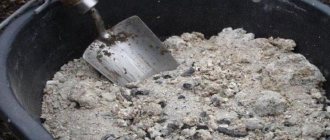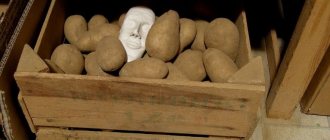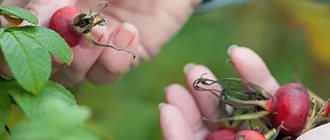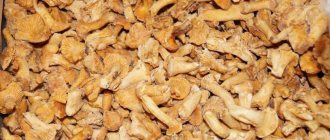How to prepare strawberries in the garden for winter - main points
Before you start covering your strawberries for the winter, you need to take some simple but necessary measures.
First of all, you need to weed the bed, removing all the weeds.
After this, you need to remove damaged and diseased leaves on the strawberry bushes, if you did not do this at the end of August. It is not worth trimming the bushes completely in front of the shelter. This will weaken the plant before wintering. You can only remove unnecessary mustaches if you did not do it in a timely manner.
Now you need to carefully loosen the rows. Loose soil breathes better and does not freeze so quickly.
Then you can add wood ash to the loose soil.
To make the ash less likely to be blown away by the wind, you can add it before loosening the soil.
That's all the preparation really is. It needs to be done before frost sets in.
How to properly insulate strawberries: step-by-step diagram
Having decided on the covering material, you can begin preparing the plantation. Regardless of where strawberries grow - in open ground or in a greenhouse - before the start of the winter season they need to be fertilized, hilled and mulched.
Experienced gardeners advise performing this work, guided by the following rules:
- At the beginning of autumn, weed and loosen the soil around the bushes. It is advisable to remove weeds from the garden bed before their seeds ripen.
Every 3–5 years, replant the bushes to a new location. If the plants remain in the same place, be sure to cut off the foliage.
At the end of August - beginning of September, trim the tendrils that the plant has produced. Otherwise, they will weaken the bush, which is extremely undesirable before wintering.
Apply organic fertilizers in the form of humus or compost. These substances will revitalize the plant and protect it from the cold. However, you should not overdo it with their quantities, since excessive doses can destroy the bushes.
Carry out preventive spraying of the bed against pests, the most common of which is the transparent mite. Fungicidal preparations or wood ash, karbofos are effective in combating it. In case of slugs and snails, it is recommended to use metaldehyde.
Further actions depend on where the strawberries grow.
In the greenhouse
Thanks to the year-round positive temperature regime, greenhouse strawberries begin to bear fruit 1.5–2 months earlier than those growing in open beds. To maintain stable heat in unheated structures, it is imperative to insulate the plantation.
The gardener must take care of this even before planting the seedlings. It is important that the soil under the strawberries does not freeze . To do this, in the place where it is planned to be planted, you need to build a low fence from beams and boards around the perimeter of the bed.
Then lay out on the bottom:
- plastic film;
- chain-link mesh;
- a layer of compost or humus up to 10 cm thick;
- a layer of mulched grass up to 12 cm thick;
- a layer of nutritious soil up to 25 cm thick.
Additionally, a low fence is made of plywood or chipboard.
Its sides are covered with plastic film or agrofibre. It is important to control the temperature so that the plant does not overripe and does not begin the premature growing season.
In the open ground
After preventive disinfection of the strawberry bed, you need to wait until it dries completely. And only then can you build a shelter. Please note that the material must completely cover the entire plantation.
Regardless of the product you choose, before covering the strawberries with it, be sure to build a fence out of boards around the perimeter of the plantation. Its height should rise 10 cm above the garden bed. Such a fence will serve as a snow trap, accumulating it in the desired area.
Then the bushes, prepared and covered with spruce branches, can be generously sprinkled with mulch. If you plan to use spunbond as a cover, you will need accurate measurements of the area. The canvas is spread over the plants and no special holes are made in it for the bushes. Such manipulations are only necessary if agrofibre is used in the spring (to kill weeds and create the desired microclimate). It is important to securely fix the edges of the fabric so that the wind does not tear them off.
Growing strawberries is a troublesome business because without the participation of human resources it is never successful. But all the energy expended will be rewarded with healthy and very tasty berries. A bountiful early harvest is quite possible with proper care.
How to protect strawberries from frost for the winter and is it necessary to do this?
Let's start with the second part of the question: is it necessary to cover strawberries for the winter?
Of course, the answer largely depends on the specific region. But in most cases this is necessary.
What troubles can arise if strawberries are not covered?
Here are the main ones.
- Return thaws, prompting flower buds to awaken. At this time there is still no snow cover, and uncovered strawberries will certainly suffer.
- If winds are considered a fairly common occurrence in your area, then at the beginning of winter snow may be blown out of the beds. In this case, uncovered strawberries may freeze already at 10-15 degrees below zero. Moreover, not only the above-ground part of the bushes can suffer, but also the roots.
- In addition, bare strawberry bushes from the cold winter wind not only freeze, but also dry out, which also leads to their death.
- And finally, after a rainy autumn, when the soil freezes, the soil may swell and young bushes may bulge out if the beds are not covered. This will lead to freezing of the root system.
It is possible not to cover strawberries for the winter only in the southern regions and in those places where the winter is mild, there is sufficient snow cover and there are practically no strong winds in winter.
But how many such regions do we have? In fact, this is an exception to the rule.
Therefore, of course, it is necessary to cover strawberries for the winter. Moreover, this is useful for two reasons. If your strawberries are not in danger of freezing, then, being covered, they will better start the growing season in the spring and give you the first harvest two weeks earlier. This is the case if it is covered, say, with spunbond. So “the game is worth the candle.”
Now about how to cover the beds with strawberries. There are quite a lot of acceptable options in this regard, so you will always have plenty to choose from.
I will list the most common of them.
Pine needles. This is an excellent material for covering strawberries for the winter. If you have a forest nearby with pine trees growing in it, then you need to go there in September and collect pine needles that have fallen under the trees with a rake into bags. This material not only retains heat well, but also has bactericidal properties.
Sprinkle the prepared pine needles onto the bushes in a small layer.
Spruce spruce branches. Another material that is well suited for covering strawberries for the winter. Again, this assumes there is a coniferous forest nearby. Pine branches will also work. This covering material does not rot and helps create a good microclimate for strawberry bushes when covered with snow. In addition, the essential oils secreted by spruce branches seem to repel rodents.
Reed .
If there is a body of water nearby, you can stock up on reeds, which are also good shelter. It retains heat well and is not blown away by the wind like, for example, hay or fallen leaves. It is easy to remove from the garden in the spring. Reed is not subject to rapid rotting. They can be covered with it, spread in a thin layer over the beds, or sewn into mats that can be used for more than one year.
Wood chips. Also a good option for covering strawberries for the winter. It attracts with its accessibility, almost does not cake, does not absorb moisture much and therefore does not freeze. You only need to use the small fraction, that is, without sticks and large fragments.
Wood shavings. In terms of its properties, the material is close to wood chips, but is lighter and fluffier, so it can be blown by the wind until it is dusted with snow. It is not difficult to obtain such material for shelter if there is some kind of wood processing enterprise.
Straw. You can also use straw to cover strawberries, but you need to choose only dry and not rotten ones. In addition, there is an opinion that straw attracts mice in winter. It is difficult to say how true this is. And the material itself is not bad, but it can also be blown by the wind. And of course, it cannot be called scarce.
Fallen leaves. Although this is affordable, it is not the best solution. The fact is that the leaves can be infected and contain pests. They quickly get wet, cake, rot and rot. If you use them as a covering material, it is better to take leaves not from fruit trees. Such, for example, as birch, aspen, poplar and others. They are less susceptible to pests.
Wood sawdust. This material is quite common, but it is not the best option. The fact is that sawdust strongly absorbs moisture and then freezes. In addition, it is advisable to remove them from the garden bed in the spring, since they can acidify the soil. But if you choose between not covering the strawberries at all or using sawdust, then it is better to at least use them.
Well, the last, but one of the best options is the use of various modern non-woven materials, which we will discuss below.
Features of wintering strawberries
Most varieties of berries tolerate winter well, as long as there is snow. If there is a blanket of snow (at least 30 cm), then in a relatively temperate climate she is in no danger.
The weather in recent years has not been stable and often presents us with all sorts of surprises. Therefore, each gardener must decide for himself whether to cover strawberries for the winter. In addition, a lot depends on the region and specific area.
Frost-resistant varieties perform well in the conditions of Siberia, the Urals, and the North. On forums, Siberians, for example, boast that they don’t cover their strawberries and get a consistently good harvest. But it should be remembered that winters in this region are snowy.
In addition, the activities that are carried out in front of the shelter are preparations for planting the future harvest. Much depends on the variety of strawberry. In order for it to take root well and overwinter, it is better to choose varieties that have adapted well specifically to your region.
Warming strawberry beds for the winter will not only protect it from weather surprises, but will also prepare it for a smooth entry into spring and lay the preconditions for a better harvest.
Preparing for insulation
At the end of summer, strawberries renew their foliage for the third time this season. During this period, the plant accumulates the substances necessary for good fruiting. Flower stalks are being laid. Therefore, it is important to help the plant accumulate strength for wintering.
Varieties of regular strawberries begin to prepare for winter earlier, remontant varieties later. The main preparation events in the middle zone are held at the end of August and September.
Important! It is impossible to cover strawberries during this period, as the berries may rot.
Thinning and renewal
A frequently asked question, especially for those new to growing, is whether it is necessary to remove strawberry leaves for the winter. No, you don't need to do this. The foliage will serve as additional shelter under the snow in winter. But it is necessary to remove the mustache, yellowed or diseased leaves.
It is important to pay attention to the fact that strawberries are divided into types: long, short, neutral and remontant.
Activities to prepare for winter for long-day strawberries begin at the end of summer, for neutral ones - the end of September. That is, when the leaves grew for the third time, fruit and vegetative buds (from which the mustache grows) took shape.
Renewing and dividing a three-year-old bush
Usually the bush grows greatly in the third year, after which the yield drops. Therefore, such bushes are renewed and planted in the fall. For this purpose, they dig up an old bush. Many side shoots with small roots form around the main bush.
The uterine bush is carefully divided, trying to preserve the young horses as much as possible. The roots of the mother bush are trimmed with pruning shears. Thus, we obtain seedlings for new beds.
Weeding loosening
After the tendrils and unnecessary leaves have been removed, they are removed and burned. Pull out all the weeds. The bushes are hilling. This must be done extremely carefully so as not to damage the roots. A few days before this, you can water the garden bed well.
Treatment and fertilization
Simultaneously with hilling, phosphorus-potassium fertilizers are applied (20 grams per 1 sq.m.). To do this, hilling is carried out twice. After the first time, spread the fertilizer, the second time mix it with the ground. Fertilizer granules will dissolve gradually and will become a good top dressing for spring. At the same time, they will feed and support the plant in winter.
Some gardeners feed with ash. Add 2 cups of ash to a bucket of water and let it sit for a couple of hours. Pour 0.5 liters per bush. Nitrogen-containing fertilizers are not recommended to be applied at all or in very limited quantities, since they can stimulate development and growth, and we need the growing season to end.
Step by step video:
How to cover strawberries for the winter with covering material and what kind of material
The most popular covering materials include Spunbond, Agrotextile (agrofabric) and Lutrasil. The properties and differences of these materials are described in detail in my article “When and how to cover roses for the winter.” By the way, if the topic of covering roses is also interesting to you, then I highly recommend reading this article. Everything is described there in great detail.
As you can see, I did not indicate plastic film as a material for covering strawberries, since it is not suitable for these purposes due to the fact that it does not breathe, unlike other materials. Therefore, it may do more harm than good.
Of the covering materials listed above, I would recommend spunbond for the reason that it is somewhat cheaper than lutrasil, and agrotextiles are available in black and are more suitable for mulching beds rather than for covering for the winter. Although, in principle, all of the listed covering materials can be used, taking into account their characteristics.
No special tricks are required to cover the beds with such material.
We take material with a density of 60-80 g/m², cut it to the required width, lay it, preferably in calm weather, on the beds with strawberries and secure it along the edges. If you do not do this, your shelter will be torn off by the wind or one of the sides will be pulled up.
The covering material can be secured along the edges with bricks, stones, boards or wire staples.
Since the specified covering material has good air permeability, you don’t have to worry about the strawberries underneath it in the spring. Therefore, you can take your time to remove it. This will only speed up the growing season and the first harvest.
How to cover remontant strawberries
The remontant berry has a peculiarity: its fruits can ripen until frost. There is no need to wait until all the berries are completely ripe, as this will take a long time. Start sheltering in mid-autumn. It is enough to cover frost-resistant remontant varieties with a layer of straw or a heap of autumn leaves.
If remontant strawberries are grown in the north, then for covering you need to use agrofibre, lutrasil or any other breathable material. If the crop has overwintered in a warm place, then in the spring it begins to bloom, and in the summer it will bear fruit earlier than usual by 1-2 weeks.
Learn how to care for strawberries in the spring for a good harvest in the summer.
How to cover strawberries for the winter in Siberia so they don’t freeze
A big advantage for preserving strawberries in garden beds in Siberia is the presence of sufficient snow cover. But since frosts can be quite severe, it makes sense to use other covering materials in addition to snow.
You can guarantee the preservation of your plantings in winter using a combined method of covering. To do this, you need to sprinkle the bushes with one of the above materials or cover them with spruce branches. And cover the top with any agrofibre, be it spunbond or lutrasil.
The advantage of spruce branches or pine branches in this case is that an air layer will be created around the bushes, which has a very beneficial effect on the preservation of plants, both at low temperatures and during thaws.
And of course, you need to ensure that the snow cover on the beds in the winter months is at least 30-40 cm.
Methods for growing strawberries in a greenhouse
Depending on the conditions and purpose, several options for planting strawberries in a greenhouse are used.
Growing strawberries in the ground in several ways is considered the most acceptable:
- Directly on the soil surface;
- In buildings in the form of racks;
- In boxes;
- In bags;
- In flowerpots, pots and other containers;
- In PVC pipes, for example for sewerage.
Recently, a new method of cultivation has been used using a hydroponics system that does not require the presence of a soil mixture. The plants are placed in PVC pipes with a diameter of 100 mm, in the upper part of which holes are made. Pots with plants are placed there.
More on the topic: How to grow strawberries correctly
Instead of a soil mixture, they come into contact exclusively with a flow of circulating water to which nutrients have been added. On 36 meters of pipe you can grow 175 bushes.
When to cover strawberries for the winter - optimal timing
Naturally, in each region the optimal time for covering strawberries will be different, so it is impossible to name any general date. You need to navigate not by numbers, but by weather and temperature.
The optimal weather for covering strawberries will be when the rains stop and the temperature reaches minus 3-5 degrees.
It is not worth covering earlier, if only because the shelter will get wet and freeze, losing its thermal insulation properties and breathability.
In addition, plants must independently and naturally adapt to lower temperatures. That is, to toughen up a little.
It’s also not worth over-delaying shelter, since strong winds are possible in central Russia at this time. In this case, the strawberries can dry out and freeze without shelter and snow cover already at a temperature of -10 degrees.
In what cases is shelter necessary?
Old, proven varieties of garden strawberries are perfectly preserved in winter without any shelter, but their sour berries leave much to be desired. This drawback became especially pronounced when we had the opportunity to try new discoveries of breeders - honey berries of modern large-fruited varieties. Unfortunately, by adding sweets, breeders greatly reduced the winter hardiness of plants. For the pleasure of feasting on this delicacy, we now have to pay with additional troubles - carefully covering such plants for the winter.
Old varieties winter well without additional shelter
A new strawberry plantation will also force you to start building a shelter. If you planted young rosettes in a new bed not in the spring, but in the second half of summer or early autumn, cover the young growth for the winter . It has not yet had time to grow a powerful root system and is therefore susceptible to bulging: moisture in the root layer turns into ice and expands, as a result of which the hearts are squeezed out of the ground. Such plants become especially vulnerable to winter wind and frost.
Young plants must be insulated
Looking for an answer to the question of whether to cover strawberries or not on country forums is a risky business. If you still want to hear the advice of experienced people, then ask only for the opinions of local residents. It is the climate characteristics of your region that will give the most correct answer. If snowless winters with severe frosts regularly occur in your area, then the solution suggests itself - it is necessary to cover.
The same applies to regions where winter often brings unpleasant surprises in the form of unexpected thaws. Strawberry takes the untimely warming as a signal to wake up, but after being deceived, she finds herself torn to pieces by frost. Proper shelter in this case will help smooth out changes in winter temperatures and preserve the strawberries.
Winter thaw threatens plant health and life
Snow is the best insulation, but if there is little or no snow, strawberries have a hard time in winter. This can happen if the bed is laid out on a slope, where in winter the snow cover is constantly blown away by the wind. Bare rosettes that are scorched by the icy wind often die in winter, so they need additional strong shelter.
Another case when insulation is necessary is a radical cutting of strawberries in the fall. This procedure is carried out by gardeners who are late with summer pruning and want to bring beauty to a neglected garden bed during the freer autumn period. Bushes that have lost their leaf caps are especially vulnerable to cold weather and suffer greatly even from low sub-zero temperatures. Such plants must be insulated without fail .
Bushes should go into winter in lush decoration
When to cover strawberries for the winter in Siberia and Altai
As for the central zone of the Russian Federation, determining the optimal timing for covering strawberries will be similar. That is, you need to wait for dry weather with a steady minus temperature of 3-5 degrees.
But there is one caveat. If in the middle zone the temperature drops quite predictably, then in Siberia and Altai there may be unpleasant surprises when the temperature during the day can vary within 10-15 degrees. And it’s good if your garden plot is within walking distance, and you can quickly respond to this and cover the strawberries.
What if the dacha plot is located outside the city, and you can’t get out to it every day?
Then you shouldn’t delay this process and cover the strawberry beds no later than the end of October. True, recently the climate in Siberia and Altai has become a little softer, but still by this time, as a rule, sub-zero temperatures are established.
Variety selection
There is no point in planting strawberries with a one-time yield. For winter fruiting, choose remontant varieties that bloom, form ovaries and berries continuously.
More on the topic: Strawberries on the windowsill
When growing bee-pollinated varieties, beehives are placed in large greenhouse structures (using Dutch technology). In the conditions of a summer cottage, it is better to carry out artificial pollination manually, using a soft brush or using a fan.
There is no need to put in additional effort if self-pollinating varieties are planted in the greenhouse. Remontant strawberries perform better than others in greenhouses:
- Albion,
- Selva,
- Queen Elizabeth 2,
- Ostara,
- Diamond,
- Monterrey and others.
It is necessary to take into account the yield, large fruit size, susceptibility to diseases and the ripening time of strawberries. It is very good to use early remontant varieties for growing in a heated greenhouse.
Even when thickened, they produce a bountiful harvest of berries that do not shrink. An early ripening perennial is beneficial in terms of using usable space: per 1 sq. m about 80 bushes are planted.
A prerequisite when selecting a strawberry variety for a greenhouse is continuous fruiting. If it occurs in waves, then you will have to waste time and wait for the next fruit formation.
Conclusions and wishes
In this article, I tried to give you recommendations on how to cover strawberries for the winter and I hope that you will use them if you see fit.
The fact is that some gardeners may claim that they never cover their strawberries and still reap good harvests. It is quite possible, but you need to have something to compare with. Try to do everything as expected, and the strawberries will respond with gratitude to your efforts. You will feel the difference when you see in the spring that not a single bush is frozen. That strawberries do not waste time and energy on recovery, but immediately begin to actively grow and develop.
I wish you rich harvests, cheerful mood and good health in our difficult times.
Best regards, Alexander Tkachenko.
Is there any point in covering strawberries?
Not a single berry crop has been able to achieve such fame and recognition among gardeners as garden strawberries. This wonderful perennial captivates with its many advantages: the unique taste and aroma of berries, high yield, early ripening and relative ease of care. It is on the concept of relativity that I would like to draw your attention today and figure out whether it is worth burdening yourself with additional efforts to insulate strawberry bushes on the eve of winter.
Is there any point in covering garden strawberries?
How to keep strawberries from freezing and how can you insulate them?
Many, even experienced, gardeners often wonder how to cover a strawberry front garden. After all, here it is important not only to strictly follow the shelter technology, but also to correctly select the necessary material.
Some solve the problem by purchasing specialized canvases, while others make do with improvised means. Judging by the reviews, agrofibre, various types of vegetation and sawdust have gained greater trust among consumers. Read on to learn about the advantages and disadvantages of each option.
What to cover
If severe winters are raging in your region, dry straw, hay, sawdust, shavings, or a thick layer of fallen leaves from under healthy trees, which the bushes are covered with, will be an excellent insulation for strawberries. These materials are economical, but have significant drawbacks: they easily fly away from the wind and are compressed in the event of a thaw. If the winter weather in your area is unstable, this option will not work - the strawberries may dry out under a damp, heavy coat.
Rodents love to huddle in straw
Such mulch becomes a cozy wintering place for voles, which in hungry times will not disdain juicy strawberry hearts. If you have suffered from rodent attacks before, it is better not to tempt them with such houses and replace these materials with spruce or pine spruce branches or pine litter.
The same applies to the stems of reeds, corn, sunflowers, etc., with which some gardeners cover strawberries for the winter. Such materials adhere firmly to the garden bed, are more breathable, but are also attractive to mice.
Strawberries can be covered with agrofibre
It is much safer to once spend money on purchasing agrofibre with a density of at least 50 g/m² and then use it for several years.
You can choose a covering material by comparing offers from different online stores on our market.
Is there any point in covering strawberries?
Not a single berry crop has been able to achieve such fame and recognition among gardeners as garden strawberries. This wonderful perennial captivates with its many advantages: the unique taste and aroma of berries, high yield, early ripening and relative ease of care. It is on the concept of relativity that I would like to draw your attention today and figure out whether it is worth burdening yourself with additional efforts to insulate strawberry bushes on the eve of winter.
Is there any point in covering garden strawberries?
In what cases is shelter necessary?
Old, proven varieties of garden strawberries are perfectly preserved in winter without any shelter, but their sour berries leave much to be desired. This drawback became especially pronounced when we had the opportunity to try new discoveries of breeders - honey berries of modern large-fruited varieties. Unfortunately, by adding sweets, breeders greatly reduced the winter hardiness of plants. For the pleasure of feasting on this delicacy, we now have to pay with additional troubles - carefully covering such plants for the winter.
Old varieties winter well without additional shelter
A new strawberry plantation will also force you to start building a shelter. If you planted young rosettes in a new bed not in the spring, but in the second half of summer or early autumn, cover the young growth for the winter . It has not yet had time to grow a powerful root system and is therefore susceptible to bulging: moisture in the root layer turns into ice and expands, as a result of which the hearts are squeezed out of the ground. Such plants become especially vulnerable to winter wind and frost.
Young plants must be insulated
Looking for an answer to the question of whether to cover strawberries or not on country forums is a risky business. If you still want to hear the advice of experienced people, then ask only for the opinions of local residents. It is the climate characteristics of your region that will give the most correct answer. If snowless winters with severe frosts regularly occur in your area, then the solution suggests itself - it is necessary to cover.
The same applies to regions where winter often brings unpleasant surprises in the form of unexpected thaws. Strawberry takes the untimely warming as a signal to wake up, but after being deceived, she finds herself torn to pieces by frost. Proper shelter in this case will help smooth out changes in winter temperatures and preserve the strawberries.
Winter thaw threatens plant health and life
Snow is the best insulation, but if there is little or no snow, strawberries have a hard time in winter. This can happen if the bed is laid out on a slope, where in winter the snow cover is constantly blown away by the wind. Bare rosettes that are scorched by the icy wind often die in winter, so they need additional strong shelter.
Another case when insulation is necessary is a radical cutting of strawberries in the fall. This procedure is carried out by gardeners who are late with summer pruning and want to bring beauty to a neglected garden bed during the freer autumn period. Bushes that have lost their leaf caps are especially vulnerable to cold weather and suffer greatly even from low sub-zero temperatures. Such plants must be insulated without fail .
Bushes should go into winter in lush decoration











